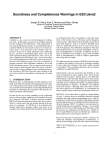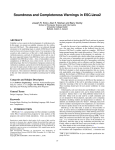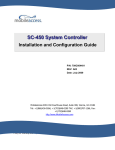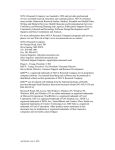Download PARIS-MB User Manual - ice
Transcript
PARIS-MB User Manual Serni Ribó Institut de Ciències de l’Espai (CSIC/IEEC) January 7th, 2014 Version 1.0 1 Instrument Description The PARIS Multi-Band receiver is a GNSS reflection receiver capable of operating at L-band and other higher (C/X/K) bands. Its signal processor implements the so-called interferometric technique [1] (PARIS-IT), that consists of cross-correlating the direct and reflected signals received by the up-looking and down-looking antennas, respectively. This instrument has been designed and manufactured at the Institut of Space Sciences (CSIC/IEEC) [3]. Figure 1 shows a block diagram of the instrument. It consists of a 19 inch rack of 3U height (labelled PARIS-MB S/P), with external additional hardware. This 19 inch rack is a dual channel L-band receiver, capable of receiving and down-converting radio signals in a sub-band of 4-40 MHz base-band bandwidth, between 1-2 GHz. Gain and bandwidth of both downconversion chains are programmable. The instrument can operate at a higher band by using external Low Noise Blocks (LNB’s) 1 that shift the signals from X-band, or any other desired band to a frequency between 1 GHz and 2 GHz. The receiver does also provides 10 MHz coherent reference clocks to feed the LNB’s, so that the down-conversion from a high frequency band is coherent with the system’s local oscillator and clocks. Any desired antenna (horn feed, horn feed with dish reflectors,. . . ) can be connected at the input of the LNB’s. The receiver samples each in-phase and quadrature component of both base-band down-converted signals at 80 Msamples/second and quantizes them using 10 bits per sample. Only the three most significant bits are used in further signal processing. 1 An LNB is a low noise amplifier followed by a down-conversion stage to intermediate frequency. 1 The digital signal processor computes the complex cross-correlation between both signals in a 200 lags window. Lag separation corresponds to one sampling period, that is, 1/80 MHz = 12.5 ns. The origin of the correlation window is selectable (from 0 lags to 255 lags) by programming individually an additional delay to each signal. A new cross-correlation is computed every millisecond. An embedded GPS receiver delivers GPS time information to the system and the obtained cross-correlation waveforms are time-tagged accordingly. Finally, the data is saved in real-time to an external (laptop) computer through an Ethernet connection. The system’s power supply is a 19 inch rack of 2U height, and it is supplied with 220V AC. The power supply is labelled PARIS-MB P/S. Figure 2 shows a picture of the the system. Power supply 19 inch rack GPS antenna GPS receiver GPS Dish Feedhorn LNB Coaxial cable Down−converter A/D converter Bias−T 10 MHz 100MHz 80 MHz 30 MHz CTRL CTRL Clock distr. 10 MHz Coaxial cable 30 MHz CTRL Data FPGA 1 board CTRL 80 MHz FPGA 2 board A/D Adapter board Feedhorn LNB Bias−T A/D converter Down−converter Signal processor User back−end Figure 1: Block diagram of the PARIS-MB receiver. 2 Interfaces Figure 2 shows a picture with all external interfaces at the front panels of the receiver and power supply. Their names and functions are shown in table 1. 2 Figure 2: Picture of the PARIS-MB receiver. 3 Data Format The data collected by the PARIS-MB receiver is saved in two types of NetCDF files: *.WAVMB.nc Contains waveforms and calibration data for a complete minute. Data rate within the file is 1 ms *.STSMB.nc Contains instrument status information for a complete minute. Data rate within the file is 1 s. 3.1 *.WAVMB.nc File Format The NetCDF data format for the waveform files consists of an array of entries, where each entry corresponds to a time-tagged complex waveform (1 ms real-time integrated) with its corresponding simultaneous Offset and PMS measurements. The contents of each field is described below: week : is the GPS week at which the measurement has been taken. sow : is the GPS second of week at which the measurement has been taken. 3 Table 1: External interfaces. Connector Function Receiver J1 RF1 (up), supply LNB J2 10MHz reference (RF1) J3 10MHz reference (RF2) J4 RF2 (down), supply LNB J5 GPS (for external GPS antenna) J6 Keyboard J7 Screen J8 Ethernet 1: 192.168.63.62 (CTRL) J9 Ethernet 2: 192.168.63.61 J10 Power Supply Input Power Supply J1 220V J2 Supply to Receiver F Fuse (3.15A) Type TNC female TNC female TNC female TNC female TNC female PS/2 VGA, DE-15 RJ-45 RJ-45 Circular multi-pin male Circular, three pins Circular multi-pin female millisecond : is the millisecond within the current sow at which the measurement has been taken. offset iup : is the DC value measurement of the in-phase component of the up signal for the current millisecond. The DC signal offset value O for signal x[n] is measured using this formula: P = −1 1 NX x[n] ko 0 (1) where N = 79, 796 is the number of signal samples integrated in 1 ms. The signal s[n] is quantized using ten bits per sample but just the three MSB are used to compute the DC offset. After N consecutive accumulations in a 22 bits register 16 bits are read out from this register. These are bits 17 down to 2. The value ko = 4 takes this into account. offset qup : is the DC value measurement of the quadrature component of the up signal for the current millisecond. The DC signal offset value O for signal x[n] is measured using the same formula as for offset iup. 4 register x[n] 23 22 3 adder 17 16 Offset readout 2 1 0 2 Figure 3: Block diagram of the signal DC offset measurement circuit. offset qdw : is the DC value measurement of the in-phase component of the down signal for the current millisecond. The DC signal offset value O for signal x[n] is measured using the same formula as for offset iup. offset qdw : is the DC value measurement of the in-phase component of the down signal for the current millisecond. The DC signal offset value O for signal x[n] is measured using the same formula as for offset iup. pms iup : is the total power measurement of the in-phase component of the up signal for the current millisecond. The total power P for signal x[n] is measured by using this formula: P = −1 1 NX x2 [n] kp 0 (2) where N = 79, 796 is the number of signal samples integrated in 1 ms. It must be taken into account that the signal s[n] is quantized using ten bits per sample but just the three MSB are used to compute the power value. After N consecutive accumulations in a 22 bits register the 16 MSB of this register are the read out value. The value kp = 64 takes this into account. pms qup : is the total power measurement of the quadrature component of the up signal for the current millisecond. It is measured in the same way as pms iup. 5 register 3 23 22 multiplier x[n] 3 22 adder 16 PMS readout 7 2 1 0 Figure 4: Block diagram of the PMS measurement circuit. pms idw : is the total power measurement of the in-phase component of the down signal for the current millisecond. It is measured in the same way as pms iup. pms qup : is the total power measurement of the quadrature component of the down signal for the current millisecond. It is measured in the same way as pms iup. ii is the real cross-correlation term between the in-phase component of the up signal and the in-phase component of the down signal for the current millisecond. The real cross-correlation at lag m, R[m] is measured using this formula: −1 1 NX y[n]x[n − m] (3) R[m] = kr 0 where N = 79, 796 is the number of signal samples integrated in 1 ms. The three MSB bits of the input signals are used to compute the product, and the accumulation register is 23 bits broad (22 bits plus one sign bit). The 16 MSB of this register are read out, so kr = 64. 3.2 *.STSMB.nc File Format The NetCDF data format for the status files consists of an array of entries, where each entry corresponds to the status of the instrument for a given second. The contents of each field is described below: x : is the x coordinate of the receiver position expressed in the ECEF (GPS) frame. 6 register (up) x[n−m] (down) y[n] 3 23 22 multiplier 3 22 adder 16 PMS readout 7 2 1 0 Figure 5: Block diagram of one single correlator lag. y : is the y coordinate of the receiver position expressed in the ECEF (GPS) frame. z : is the z coordinate of the receiver position expressed in the ECEF (GPS) frame. week : is the GPS week at which the measurement has been taken. sow : is the GPS second of week at which the measurement has been taken. pv : is a boolean that indicates if the time (week, sow) and position (x, y, z) are valid. N : The local oscillator frequency is obtained by programming the MAX2112 mixing stage [2]. The local oscillator frequency FLO is obtained from the mixer frequency FM IX = FREF by using the formula FLO = M FREF (4) where M is a rational multiplier. N is the integer part of M . F : The local oscillator frequency is obtained by programming the MAX2112 mixing stage [2]. The local oscillator frequency FLO is obtained from the mixer frequency FM IX = FREF by using (4). F is the fractional part of M . BW : The bandwidth of the down-conversion chain can selected by programming the MAX2112 mixing stage. This field holds the value of register 9 (LPF) of the MAX2112 down-converter [2]. The actual 3dB bandwidth is obtained by using the formula f−3dB = 4 MHz + (BW − 12) · 0.290 MHz 7 (5) BBG up : The gain of the MAX2112 mixing stage can be adjusted at baseband by programming its control register (bits BBG) [2]. This field holds the baseband gain for the up channel expressed in dB (from 0dB to 15dB in 1dB steps). BBG up : The gain of the MAX2112 mixing stage can be adjusted at baseband by programming its control register (bits BBG) [2]. This field holds the baseband gain for the down channel expressed in dB (from 0dB to 15dB in 1dB steps). VAS : The MAX2112 down-conversion stage includes 24 VCOs. The local oscillator frequency can be manually selected, and by setting the VAS bit to logic ’1’the MAX2112 selects automatically the appropriate VCO. [2]. freq : Most recent estimation of the reference clock frequency. Nominal frequency is FREF = 80MHz. Frequency count is given in counts per minute minus 232 . So, a reading of 505,032,893 corresponds to a refer32 = 80, 000, 003.15 MHz. ence frequency of FREF = 505,032,893+2 60 LNB fact A 10MHz frequency is delivered to the LNB blocks to generate the local oscillator frequency of the LNB FLN B . This LNB local oscillator frequency is obtained by multiplying the 10MHz frequency by a multiplication factor. FLN B = LN Bf act 10 MHz (6) GRF coarse up : The gain of the MAX2112 down-converter can be adjusted at RF by setting a control voltage [2]. This is accomplished by using two digitally programmable potentiometers, one for coarse adjustment of the voltage and a second one for fine adjustment. This variable holds the programming value for the coarse adjustment of the up chain. GRF fine up : The gain of the MAX2112 down-converter can be adjusted at RF by setting a control voltage [2]. This is accomplished by using two digitally programmable potentiometers, one for coarse adjustment of the voltage and a second one for fine adjustment. This variable holds the programming value for the fine adjustment of the up chain. GRF coarse dw : The gain of the MAX2112 down-converter can be adjusted at RF by setting a control voltage [2]. This is accomplished by 8 using two digitally programmable potentiometers, one for coarse adjustment of the voltage and a second one for fine adjustment. This variable holds the programming value for the coarse adjustment of the dw chain. GRF fine up : The gain of the MAX2112 down-converter can be adjusted at RF by setting a control voltage [2]. This is accomplished by using two digitally programmable potentiometers, one for coarse adjustment of the voltage and a second one for fine adjustment. This variable holds the programming value for the fine adjustment of the dw chain. RUN : This boolean variable indicates if the correlator was running. LSB : The correlation data is accumulated in a 23-bits register, but only 16 bits are read-out. This variable shows the LSB bit that is being read out from the accumulator. TEST : Indicates whether an external signal is used (’0’) or an internal test signal (’1’). SRC UP : Meaningful only when TEST=’0’. If SRC UP=’1’ the signal input into connector J1 (up) is used, otherwise the signal input into connector J4 (down). SRC DW : Meaningful only when TEST=’0’. If SRC DW=’1’ the signal input into connector J1 (up) is used, otherwise the signal input into connector J4 (down). I UP A0 : This is the filter coefficient aq for q = 0 in (7), for the in-phase component of the up signal. All signal components are digitally filtered digitally (FIR/IIR) before being cross-correlated. The filter function is Q X aq z[n − q] = X bp x[n − p] (7) p=0 q=0 where x[n] is the input signal and z[n] the output signal. I UP A1 : This is the filter coefficient aq for q = 1 in (7), for the in-phase component of the up signal. I UP A2 : This is the filter coefficient aq for q = 2 in (7), for the in-phase component of the up signal. I UP A3 : This is the filter coefficient aq for q = 3 in (7), for the in-phase component of the up signal. 9 I UP B0 : This is the filter coefficient bp for p = 0 in (7), for the in-phase component of the up signal. I UP B1 : This is the filter coefficient bp for p = 1 in (7), for the in-phase component of the up signal. I UP B2 : This is the filter coefficient bp for p = 2 in (7), for the in-phase component of the up signal. I UP B3 : This is the filter coefficient bp for p = 3 in (7), for the in-phase component of the up signal. Q UP A0 : This is the filter coefficient aq for q = 0 in (7), for the quadrature component of the up signal. Q UP A1 : This is the filter coefficient aq for q = 1 in (7), for the quadrature component of the up signal. Q UP A2 : This is the filter coefficient aq for q = 2 in (7), for the quadrature component of the up signal. Q UP A3 : This is the filter coefficient bp for q = 3 in (7), for the quadrature component of the up signal. Q UP B0 : This is the filter coefficient bp for p = 0 in (7), for the quadrature component of the up signal. Q UP B1 : This is the filter coefficient bp for p = 1 in (7), for the quadrature component of the up signal. Q UP B2 : This is the filter coefficient bp for p = 2 in (7), for the quadrature component of the up signal. Q UP B3 : This is the filter coefficient bp for p = 3 in (7), for the quadrature component of the up signal. I DW A0 : This is the filter coefficient aq for q = 0 in (7), for the in-phase component of the down signal. I DW A1 : This is the filter coefficient aq for q = 1 in (7), for the in-phase component of the down signal. I DW A2 : This is the filter coefficient aq for q = 2 in (7), for the in-phase component of the down signal. 10 I DW A3 : This is the filter coefficient aq for q = 3 in (7), for the in-phase component of the down signal. I DW B0 : This is the filter coefficient bp for p = 0 in (7), for the in-phase component of the down signal. I DW B1 : This is the filter coefficient bp for p = 1 in (7), for the in-phase component of the down signal. I DW B2 : This is the filter coefficient bp for p = 2 in (7), for the in-phase component of the down signal. I DW B3 : This is the filter coefficient bp for p = 3 in (7), for the in-phase component of the down signal. Q DW A0 : This is the filter coefficient aq for q = 0 in (7), for the quadrature component of the down signal. Q DW A1 : This is the filter coefficient aq for q = 1 in (7), for the quadrature component of the down signal. Q DW A2 : This is the filter coefficient aq for q = 2 in (7), for the quadrature component of the down signal. Q DW A3 : This is the filter coefficient bp for q = 3 in (7), for the quadrature component of the down signal. Q DW B0 : This is the filter coefficient bp for p = 0 in (7), for the quadrature component of the down signal. Q DW B1 : This is the filter coefficient bp for p = 1 in (7), for the quadrature component of the down signal. Q DW B2 : This is the filter coefficient bp for p = 2 in (7), for the quadrature component of the down signal. Q DW B3 : This is the filter coefficient bp for p = 3 in (7), for the quadrature component of the down signal. delay offset : The up signal can be delay by an integer amount of clock cycles (lags). This value indicates the magnitude of the delay. delay up 0 : Constant group delay component (d0 ) applied to the up signal during the current second (see equation (8)). The signal processor 11 applies a dynamic group delay to the input signals, which is modelled by a polynomial τ = d0 + d1 t + d2 t2 (8) delay up 1 : Linear group delay component (d1 ) applied to the up signal during the current second (see equation (8)). delay up 2 : Quadratic group delay component (d2 ) applied to the up signal during the current second (see equation (8)). phase up 0 : Constant phase component (φ0 ) applied to the up signal during the current second (see equation (9)). The signal processor applies a dynamic phase model to the input signals, which is modelled by a polynomial (9) φ = φ0 + φ1 t + φ2 t2 phase up 1 : Linear phase component (d1 ) applied to the up signal during the current second (see equation (9)). phase up 2 : Quadratic phase component (d2 ) applied to the up signal during the current second (see equation (9)). delay dw 0 : Constant group delay component (d0 ) applied to the down signal during the current second (see equation (8)). delay dw 1 : Linear group delay component (d1 ) applied to the down signal during the current second (see equation (8)). delay dw 2 : Quadratic group delay component (d2 ) applied to the down signal during the current second (see equation (8)). phase dw 0 : Constant phase component (φ0 ) applied to the down signal during the current second (see equation (9)). phase dw 1 : Linear phase component (d1 ) applied to the down signal during the current second (see equation (9)). phase dw 2 : Quadratic phase component (d2 ) applied to the down signal during the current second (see equation (9)). 12 References [1] M. Martin-Neira, S. D’Addio, C. Buck, N. Floury, and R. Prieto-Cerdeira. The PARIS Ocean Altimeter In-Orbit Demonstrator. Geoscience and Remote Sensing, IEEE Transactions on, 49(6):2209 –2237, June 2011. [2] MAX2112 Complete, Direct-conversion Tuner for DVBS2 Applications. Technical report, Maxim, 2010. [3] Serni Ribo, Juan Carlos Arco, Santi Oliveras, Antonio Rius, and Christopher Buck. Experimental results of an X-band PARIS receiver using digital satellite TV opportunity signals scattered on the sea surface. Submitted to Geoscience and Remote Sensing, IEEE Transactions on, 2013. 13



















